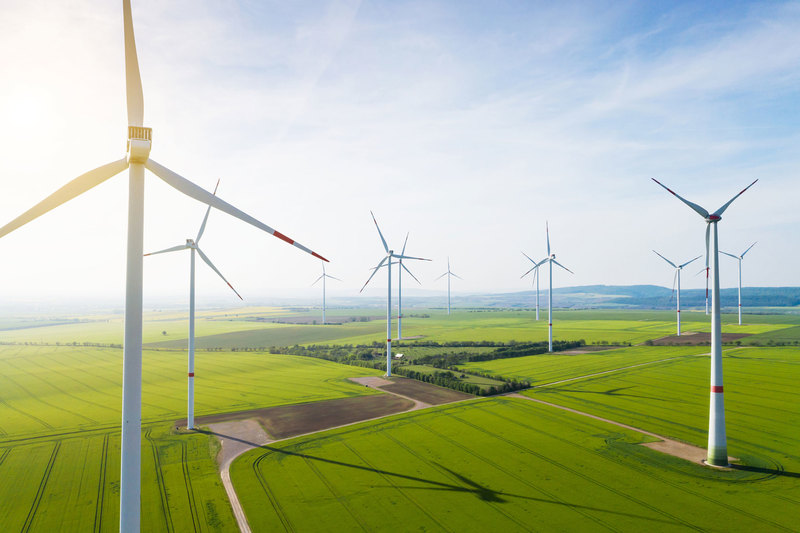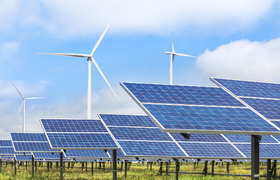Earth Day: Cheaper renewable energy a game changer in SA’s emissions targets
22 April 2021 | Story Andrew Marquard, Helen Swingler. Photo Getty Images. Read time 10 min.
Cheaper renewable energy is beginning to change South Africa’s greenhouse gas emissions dramatically, and the prognosis for South Africa’s 2030 climate mitigation targets under the Paris Agreement is that these emissions can be reduced significantly.
This is the gist of a revised model produced by a University of Cape Town (UCT) multidisciplinary team. The team was contracted by the national Department of Forestry, Fisheries and the Environment (DFFE) to undertake the technical work to update South Africa’s greenhouse gas targets under the Paris Agreement – and to help draft South Africa’s Nationally Determined Contribution (NDC) itself.
“It is encouraging that some of the scenarios modelled foresee South Africa’s emissions in 2030 [as] significantly lower than [even] the lower limit of 398 megatonnes (Mt) currently enshrined in policy,” said Professor Harro von Blottnitz, the head of the Energy Systems Research Group (ESRG) in UCT’s Department of Chemical Engineering.
The team, led by Dr Andrew Marquard, provided “strong evidence” that the upper limit of South Africa’s expected greenhouse gas emissions target in 2030 could be revised downwards by 28% (from 614 Mt to 440 Mt) without damaging the prospects of economic recovery and growth, said Von Blottnitz. This is good news for the economy, in the wake of the COVID-19 pandemic.
“Systems intelligence of this type can provide robust evidence for South Africa to play its part in the international climate change mitigation effort – in a way that enhances, rather than undermines, national development ambitions,” said Von Blottnitz.
The team combines a complete engineering-based energy sector model coupled with a computable general equilibrium economy-wide model, to quantify energy and emission futures relative to the performance of the national economy.
Dr Marquard spoke with UCT News about the project, its ramifications and its challenges.
Helen Swingler (HS): What was the background, scope and aim of the modelling project?
Andrew Marquard (AM): Climate change is currently regarded as the most serious and urgent challenge facing humanity, and one which requires a global response. Since 1992 countries have been negotiating a multilateral response to climate change under the United Nations Framework Convention on Climate Change (UNFCCC), and in 2015 countries concluded the landmark Paris Agreement, which lays out a number of key global goals to address the climate crisis and avoid and reduce its impact as far as possible.
The agreement aims to keep global warming to “well below 2°C ”, and to pursue efforts to limit warming to 1.5°C , and requires each country to periodically submit an NDC to this overall global goal. This consists of each country’s commitment to reducing greenhouse gas emissions, with the aim (in the long term) of reducing emissions to zero. In addition, the agreement also recognises that adapting to climate change is a global effort, and sets out how this will be achieved. It specifies that support will be provided to developing countries, both for reducing emissions and for adaptation. South Africa was deeply involved in negotiating the Paris Agreement, and ratified the agreement in 2016.
One of South Africa’s obligations is to submit an NDC every five years that lays out the country’s mitigation target (a target for reducing our greenhouse gas emissions), its adaptation plans, and the support we will need from the international community. Since South Africa’s last NDC was submitted in 2015, an updated NDC was due in 2020. Due to the COVID-19 pandemic, this was postponed, and will be submitted in 2021.
HS: You mentioned that this was a multidisciplinary effort, involving several UCT departments and entities. Who was involved, and what were their main responsibilities and contributions?
AM: The team comprises researchers from the ESRG, including myself; Professor Harro von Blottnitz, who focused on emissions from the waste sector; Bruno Merven; Alison Hughes; Fadiel Ahjum; and Bryce McCall and Jesse Burton, who specialise in the electricity sector and energy-economic linkages, the buildings sector, transport, industry and climate policy, and the just transition.
ESRG researchers were joined by Professor Harald Winkler, who specialises in national and international climate and development policy; Faaiqa Hartley, an economist and economic modelling specialist from the Southern Africa Labour and Development Research Unit in the School of Economics; Associate Professor Brett Cohen from Chemical Engineering and The Greenhouse; Dr Luanne Stevens from Wits and Jacali Consulting, a land sector greenhouse gas specialist; environmental engineer Julia McGregor; and Anthony Dane from Change Pathways in the role of project manager; as well as two interns, Dr Deepti Charitar (who recently completed her PhD in energy studies), and master’s student Joseph Masenda. The team included researchers with backgrounds in a wide range of disciplines and expertise, including natural sciences, engineering, economics, political science and international climate law and policy. Two members of the team are also senior members of the South African delegation to the UNFCCC.
What is also remarkable is that the team was not able to meet physically, as the project began during the first COVID-19 lockdown and was run entirely ... on the Zoom platform.
HS: That’s a remarkable feat in itself. What are the project’s key results?
AM: The technical analysis included several components. First, an assessment of what South Africa’s “fair share” of the remaining global emissions budget is over the next decade. Second, our legal obligations in terms of greenhouse [gas] emissions reduction under the Paris Agreement. And finally, the biggest part of the project: energy-economy-environment modelling of emissions scenarios for South Africa, with and without the implementation of current policies and plans to reduce greenhouse gas emissions, and with different economic growth rates.
“The modelling framework can therefore not only evaluate policy interventions to reduce emissions, but also report on their social-economic outcome.”
The modelling was undertaken using the South African TIMES linked General Equilibrium model (SATIMGE) modelling framework, which integrates a technology-based energy/emissions model (SATIM), and an economic model (ESAGE) built and maintained by the ESRG. The modelling framework was further enhanced by the addition of waste and land and agriculture models, so all greenhouse gas emission sources are covered. The modelling framework can therefore not only evaluate policy interventions to reduce emissions, but also report on their social-economic outcome and other indicators vital to policymakers.
HS: Were the results of the modelling a surprise?
AM: The results of the modelling analysis were striking. Since South Africa’s first NDC was communicated to the UNFCCC, the economics of reducing greenhouse gas emissions has changed dramatically because of the fall in the costs of renewable energy. In addition, over the past decade the South African economy has become far less electricity- and emissions-intensive. On top of this, the impact of the COVID-19 pandemic on the economy will significantly reduce emissions for the next decade compared to previous trends. During this time, the energy transitions in the electricity and transport sectors will accelerate. As a result of these changes, the team was able to recommend to the South African government that our greenhouse gas emissions targets for 2025 and 2030 could be lowered considerably, without compromising economic growth and efforts to meet South Africa’s development challenges.
“One of the key challenges in modelling the emissions targets was how to consider the COVID-19 pandemic.”
The team also assisted the DFFE in drafting a revised NDC, with revised greenhouse gas targets, based on the team’s analysis. The revised NDC was approved by Cabinet and released for public consultation at the end of March. The team will provide additional support in the finalisation of the NDC, which is due to be communicated to the UNFCCC by November 2021.
HS: It was clearly a complex undertaking, in difficult times. What were the key challenges?
AM: During the research process, the team worked closely with the international and national climate change teams in the DFFE, and especially with the DFFE national greenhouse gas inventory team. During this process there was considerable mutual learning: the calibration and accuracy of the UCT ESRG team’s modelling framework was considerably improved, and the UCT team was able to provide key inputs to the revision of the national greenhouse inventory, and quantify the greenhouse gas and other impacts of a range of policies and programmes. The NDC will guide South Africa’s climate policy and its implementation up to 2030.
One of the key challenges in modelling the emissions targets was how to consider the COVID-19 pandemic and its implications for economic growth and greenhouse gas emissions in 2020 and for the decade ahead. Since the project was started in 2020, at the beginning of the first lockdown, addressing this uncertainty was very challenging. In addition, several team members had COVID-19 themselves. New ways of working virtually were pioneered during the project. What would normally have taken a number of trips to Pretoria was all accomplished virtually, saving time – and greenhouse emissions.
Professor von Blottnitz has nominated this team for the National Research Foundation Team Award 2021.
 This work is licensed under a Creative Commons Attribution-NoDerivatives 4.0 International License.
This work is licensed under a Creative Commons Attribution-NoDerivatives 4.0 International License.
Please view the republishing articles page for more information.










